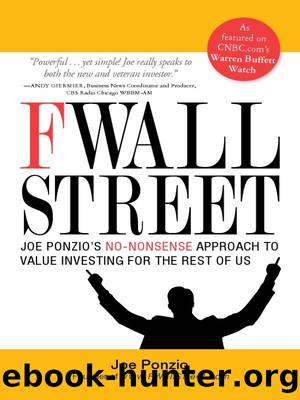F Wall Street: Joe Ponzio's No-Nonsense Approach to Value Investing For the Rest of Us by Joe Ponzio

Author:Joe Ponzio [Ponzio, Joe]
Language: eng
Format: epub
Tags: Non-Fiction
Publisher: F+W Media
Published: 2009-05-17T18:30:00+00:00
Coca-Cola, Cash Yield versus T-Bond, 1992â2008
Was an investment in Coca-Cola warranted? Not according to the cash yield. When comparing the two investments (Coca-Cola and the T-Bond), the T-Bond was the clear winner for more than a decade. It wasnât until early in 2005 that Coca-Cola became an attractive buy.
With a cash yield of 5.7 percent versus the T-Bond at 4.3 percent, the markets would have been offering you a 30 percent margin of safety on your investmentâa fair margin on such a large, stable company. From a January 2005 purchase to the end of 2007, you would have earned 14 percent a year, on averageâor, 17.5 percent with dividends reinvested.
Based solely on the cash yield method, Coca-Cola would not have been a very attractive investment from 1992 to 2005. Although you would have earned an average annual return of more than 8 percent on your investment in Coca-Cola during that timeâmore than if you left your money in cashâyou would have been better off finding other opportunities during those thirteen yearsâopportunities that were offering safety and a more satisfactory return.
If your goal was to earn an average annual return of 10 percent, you would have been sorely disappointed as a 1992 purchaser of Coca-Cola.
THE BUY-AND-HOLD VALUATION
The cash yield tells us that Coca-Cola may have been overpriced in the mid- to late-1990s and early 2000s, but that a buying opportunity may have presented itself in 2005 or so. Letâs see if that is true using the buy-and-hold valuation.
Again using a 9 percent discount rate, weâll assume that Coca-Cola would grow at 20 percent initiallyâsomewhat less than its CROIC of 24 percent during those sixteen yearsâand that growth would increase less and less each year, from 20 percent initially to 13 percent in year ten, ultimately slowing to 5 percent in years eleven through twenty. Starting in 1992, we would have projected 1993 owner earnings to be 20 percent higher than 1992âs $1.18 billion. Similarly, we would expect 1994âs owner earnings to be roughly 19 percent (95 percent of 20 percent) higher than those of 1993, or $1.68 billion. And so on through 2012.
You may be thinking, âGrowth at 20 percent? Not Coca-Cola! Itâs too big!â Thatâs why we scale down the growth over time. Still, Coca-Cola averaged $1.5 billion of owner earnings in 1992 and 1993, and generated an average of $3.6 billion in 1996 and 1997. Its ability to generate cash continued to grow, from $1.18 billion in 1992 to $6.3 billion in 2007âat an actual rate of 11.8 percent versus our 1992 projection of 12.2 percent (taking into account early growth at 20 percent, then scaled down) during that time. Thus, we were not too far off.
So, starting in 1992, Coca-Cola reports shareholder equity of $3.9 billion. Using our above assumptions, we find that the present value of the future cash we think the business could generate is $35.9 billion. Adding the two together, we get an intrinsic value for Coca-Cola of roughly $39.8 billion.
During that year, Coca-Colaâs market capitalization was between $47.
Download
This site does not store any files on its server. We only index and link to content provided by other sites. Please contact the content providers to delete copyright contents if any and email us, we'll remove relevant links or contents immediately.
| Analysis & Strategy | Bonds |
| Commodities | Derivatives |
| Futures | Introduction |
| Mutual Funds | Online Trading |
| Options | Portfolio Management |
| Real Estate | Stocks |
Pioneering Portfolio Management by David F. Swensen(5621)
Rich Dad Poor Dad by Robert T. Kiyosaki(5176)
How To Win Friends and Influence People by Dale Carnegie(3793)
The Money Culture by Michael Lewis(3299)
The Dhandho Investor by Mohnish Pabrai(3181)
The Wisdom of Finance by Mihir Desai(3096)
Liar's Poker by Michael Lewis(2824)
The Intelligent Investor by Benjamin Graham Jason Zweig(2604)
The ONE Thing by Gary Keller(2538)
Mastering Bitcoin: Programming the Open Blockchain by Andreas M. Antonopoulos(2525)
Investing For Dummies by Eric Tyson(2480)
How to Day Trade for a Living: Tools, Tactics, Money Management, Discipline and Trading Psychology by Andrew Aziz(2460)
How to Win Friends and Influence People by Dale Carnegie(2454)
Rich Dad Poor Dad: What The Rich Teach Their Kids About Money - That The Poor And Middle Class Do Not! by Robert T. Kiyosaki(2443)
Fooled by Randomness: The Hidden Role of Chance in Life and in the Markets by Nassim Nicholas Taleb(2428)
Zero Hour by Harry S. Dent Jr. & Andrew Pancholi(2255)
Market Wizards by Jack D. Schwager(2173)
Rich Dad's Guide to Investing by Robert T. Kiyosaki(2122)
How to Pay Zero Taxes, 2018 by Jeff A. Schnepper(2111)
